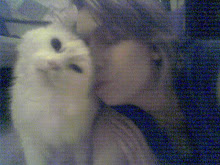Parallel Distributed Processing: An example of my ability to regurgitate words without understanding
Here's an example of my class project for tomorrow. All I have to do is find an article that is relevant to the readings and then describe it. Doesn't sound so hard, right? WRONG! See for yourself. (I actually wrote this, please don't steal without citing me.)
Rogers and colleagues (2004)* developed a parallel distributed processing (PDP) model of semantic knowledge based on Wernicke's theory that the interaction of different modalities gives rise to semantic knowledge. In particular, the authors selected visual representations and verbal propositions as input for the PDP model and conducted hierarchical cluster analysis on the results of norming studies of attribute lists and drawings of objects in order to determine the structure of a set of objects (e.g., animals, fruits, and man-made artifacts). With input across modalities (i.e., verbal and visual) the PDP model was able to learn the name of the object given a certain set of visual and verbal information (e.g., has stripes) that distinguished the object from another semantically related object (e.g., zebra vs horse). The structure that the PDP model yielded was very similar to the structure based on the norming data, but the structure incorporating information from both modalities was slightly different from the structure derived from either modality individually. The authors suggested that the PDP model was composed of hidden units that mediated interaction between input units from different modalities and output units. Rather than being a repository of facts about objects, these hidden units encode the semantic similarity relationships between objects. Therefore, the authors suggest that the re-representation of objects based on interacting information from various modalities is an important function of the semantic system.
Rogers and colleagues (2004) tested the model against neuropsychological data on various tasks given to semantic dementia patients, whose ability to name objects steadily decreases with time. Semantic dementia patients present with bilateral deterioration of the temporal pole. Correspondingly, the authors increasingly degraded the number of operational units and ran simulations of neuropsychological tasks by presenting the model with inputs and determining whether the model could give the correct output. Varying the severity of the degradation of the PDP model mimicked error patterns in dementia patients at different stages in the progression of the disease. For example, without the operation of units that specified unique propositions, the model tended to drift into another "attractor set" that resulted in a semantically similar answer (e.g., "dog" rather than "goat"), or different "attractor sets" merged into a more typical pool and the input resulted in a correct answer that was more superordinate than would typically given (e.g., "bird" rather than "raven"). Also, at more severe disease states, corresponding to greater overall degradation, the typical output was a failure to provide any answer at all (i.e., anomia).
By combining neuropsychological and computational modeling techniques, the authors concluded that the results of the study provided evidence that an amodal PDP model is a good representation of the organization of the semantic system. The temporal pole is organized in such a way that it receives input from all of the sensorimotor association areas. Therefore, the temporal pole is a good candidate for the seat of the semantic system, because it fulfills the function of the hidden units in the PDP system by integrating and re-representing information from various modalities to arrive at the correct semantic output.
Makes sense? Yeah, I didn't think so. Now I have to present this to the class tomorrow. But, I have to describe it in layman's terms which is significantly more difficult than a technical write-up in which I try to summarize in my own words, while remaining faithful to the verbiage of the original article. Now I have to assume my audience doesn't know anything about the topic and I'll have to explain what absolutely everything means. Wish me luck. I'm going to need it.
*Sorry, I decided to delete this reference because I gave it out to everyone in my class and they might decide to search for it and find this blog. (Use Google Scholar, people! Not just plain Google. Please comment if you would actually like to find this reference.)




0 Comments:
Post a Comment
<< Home